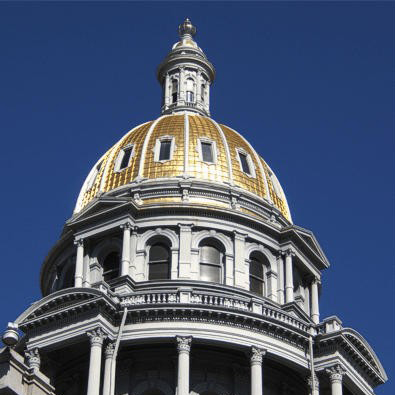The potential for introducing small-modular reactors (SMRs) to Colorado will get a second look at the state legislature thanks to a new bill currently being considered.
HB23-1080, sponsored by Representative Ty Winter (R.) and Senator Byron Pelton (R.), would direct the Colorado Energy Office to conduct a feasibility study for the use of SMRs as a carbon-free resource in the state’s energy mix.
According to the bill’s current language, the study must evaluate the following:
(I) EXISTING STATE LAW TO DETERMINE AND IDENTIFY WHICH, IF ANY, STATUTES AND AGENCY RULES WOULD NEED TO BE AMENDED TO ENABLE THE CONSTRUCTION AND OPERATION OF SMALL MODULAR NUCLEAR REACTORS IN THE STATE;
(II) THE ECONOMIC FEASIBILITY OF REPLACING CARBON-BASED ENERGY SOURCES WITH REACTORS, WHILE ACCOUNTING FOR THE NET PRESENT VALUE OF REVENUE REQUIREMENTS THAT WOULD RESULT FROM THE RETIREMENT OF COAL-FIRED PLANTS;
(III) THE SAFETY OF AND THE WASTE STREAM RESULTING FROM THE CONSTRUCTION AND OPERATION OF REACTORS; AND
(IV) THE PROPERTY TAX BENEFITS TO COUNTIES, SCHOOL DISTRICTS, AND SPECIAL TAXING DISTRICTS IN CONNECTION WITH THE USE OF REACTORS;
Additionally, the bill would also direct the study to document:
(b) AN ESTIMATE OF THE NUMBER OF JOBS THAT COULD BE CREATED AND THE OVERALL IMPACT TO LOCAL ECONOMIES IN CONNECTION WITH THE USE OF SMALL MODULAR NUCLEAR REACTORS;
(c) A COMPARISON OF THE RELIABILITY AND COST OF SMALL MODULAR NUCLEAR REACTORS AND OF NATURAL GAS, WIND, AND SOLAR ENERGY PRODUCTION;
(d) THE IDENTIFICATION OF LOCAL GOVERNMENT PERMITTING REQUIREMENTS OR APPROVALS THAT WOULD BE REQUIRED FOR THE OPERATION OF SMALL MODULAR NUCLEAR REACTORS IN THE STATE; AND
(e) ANY OTHER INFORMATION THAT THE DIRECTOR DEEMS NECESSARY.
The bill is largely identical to the one introduced last session by then-Senator Bob Rankin (R.). Rankin’s bill was unceremoniously assigned to the Senate State Affairs Committee—commonly referred to as the “kill committee”—by the Democratic majority shortly after being introduced. With Democrats only increasing their majority margins in both chambers since that effort, there’s no guarantee this latest bill won’t see a similar early demise.
However, there are some reasons to suggest that this latest effort to incorporate nuclear into the energy conversation will fare better than the last. The bill has, for the time being at least, been assigned to the House Energy and Environment committee. Democrats currently enjoy an 8-3 majority on that committee, meaning it will still take a monumental showing of bipartisanship for it to advance. Still, the fact that it was sent to a serious committee suggests that it might get a fair shake this time around.
Additionally, much has changed in the last year both nationwide and around the world to elevate nuclear power’s stature in the current discourse over prudent energy policy. The Russian invasion of Ukraine has led to a massive rethinking of nuclear power’s role in ensuring energy security and reliability, as demonstrated by the course reversal of previously anti-nuclear countries like Germany and Japan.
In the U.S., concerns over grid reliability and the pace and scale of the clean energy transition have also begun to cast nuclear in a new light. California decided to postpone the phaseout of its last remaining nuclear plant, for example, after facing recurring blackout threats due to its unreliable and inadequate electricity supply.
As a result, public opinion on nuclear power has followed suit. Broad, bipartisan majorities of the American public now say they are in favor of nuclear energy, while support for the technology within the federal government continues to be bipartisan as well.
Furthermore, new evidence continues to pile up showing the untapped potential for advanced nuclear energy to help the U.S. reliably decarbonize the power sector. Last September, the Department of Energy released a study extolling the benefits of replacing the nation’s operational and recently retired coal plants with advanced reactors. Five of the coal plants identified by the report were located right here in Colorado.
New DOE Study Finds 5 Coal Plant Sites in Colorado That Could Convert to Nuclear
Grid reliability is undoubtedly a live concern among Colorado’s policymakers as the state continues to rely more and more on weather-dependent energy sources. The Colorado Public Utilities Commission has already sounded the alarm over rising grid reliability risks, and the performance of the state’s energy mix during recent cold snaps has shown how much fossil fuels still carry the load when it really counts.
Nuclear’s zero-carbon, 24/7 generation characteristics could certainly help play a role in threading the needle between the twin goals of reliability and decarbonization.
Against this backdrop, lawmakers will again consider approving a feasibility study for advanced nuclear power. While there’s no guarantee that partisanship and recalcitrant anti-nuclear ideology won’t overshadow what’s happened in the last year, it is clear that there’s never been a more opportune time for the state to consider atomic energy.








